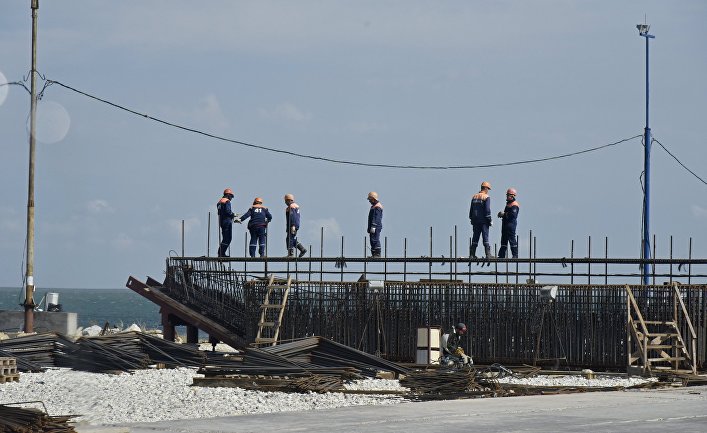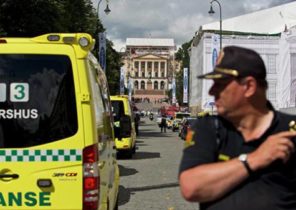
Russian President Vladimir Putin described the construction of a bridge between Russia and the occupied Crimea “historical mission”. However, it is worth to look more closely at history. This mission is doomed to failure, not only because of the sanctions. Experts warn that, even if this bridge will be able to finish, the probability that it will last long enough is quite small.
Talking about the construction of a bridge across the Kerch Strait — the place where the merge of the Azov and Black seas — which would connect Russia and Crimea, being long. However, during this time, was made only one attempt to bring this idea to life. In 1944, the Soviet army built a bridge with a length of 4.5 kilometers. Within just six months supports were destroyed by ice blocks. A quick end for the most part makeshift bridge does not mean that built according to the rules the bridge will also stand for long. But it is noteworthy that none of the many schemes proposed in the period of the Soviet Union, and then independent Ukraine were not realized.
The construction of 19-kilometer bridge across Tuzlanskog braid began soon after the annexation of Crimea. This haste was not the whim of Putin. Despite persistent statements that the Crimea really belongs to Russia, in fact, this Peninsula still depends on Ukraine in matters of water supply, electricity and other basic goods. Bridge can radically change the situation.
George Rosnowski the author of two Ukrainian projects of bridge across Kerch Strait, not understand why was chosen this plan of a bridge across Tuzlanskog braid. According to him, this is the most complex and expensive option. It is possible, provided generous funding for this bridge will be completed, however Rosnovski doubt that it will stand long enough because of the complex geological conditions. We are talking about deep-seated mud volcanoes and muddy bottom, which is not suitable for the construction of the base of the bridge. Most importantly, this area is characterized by high seismic activity. Piles must be laid much deeper than envisaged in the current draft, so Rosnovski believes that this design is likely to be weak. In addition, the spans of the bridge should be more than 200 meters to avoid being damaged by freezing water. In the current draft it is not.
Rosnowski also pointed to the issue of the proposed height of the bridge. According to the Russian project, the height of the bridge will be 35 metres, whereas in the Ukrainian projects were encouraged to build it at least 50 meters. A high enough bridge to prevent the movement of ships in the area, especially in storm conditions. Turkish trawler has managed to crash into temporary bridge supports.
Criticism on the part of Russia. Russian engineer Yury Sevenard expressed similar concerns about the geological features, seismic activity and extreme weather conditions. And in December 2016 Yuri Medovar of the Russian Academy of Sciences said that the bridge is built in the absence of proper project, because nobody wants to take responsibility for it. According to him, the bridge is impossible to build, and Yes God help us with this bridge, because it won’t last long.
But Putin wanted the bridge immediately. This meant the rejection of inconvenient assess the possible impact on the environment and public discussions. The state Duma quickly approved a law allowing the rapid and uncontrolled build — ecologist Dmitry Shevchenko called it a desecration of the law and the Russian Constitution. From the outset it was assumed that the bridge will be designed and build at the same time, and permits is just a formality.
Even this law was passed after conducted initial preparatory work. The contract for the construction of the bridge was awarded in January 2015 with the company SGM Group, owned by Putin’s friend Arkady Rotenberg. Rotenberg said that doing it “for the country.” Meanwhile, according to media reports, he and his brother had benefited from contracts for the construction of Olympic facilities in Sochi. It was clear that he would not worry about possible harm to the environment, safety, and rights of the local residents.
No worries no high probability of a bridge collapse or possible negative consequences to the environment or disruption of water flows between the Black and Azov seas. The organization Environmental Watch and other activists warned of irreversible consequences for the flora and fauna of the region.
The Kremlin has invested a lot of money in a propaganda campaign to promote this project worth 4.5 billion dollars, but costs continue to rise. The second tender for the construction of railway approaches to the bridge failed due to lack of applications. Contractors must be wary to take too large risks, as insurance companies do not take such clients. According to Maxim Gardus, a journalist working in the field of transport, two thousand companies have denied coverage of this project. The newspaper “Vedomosti” reported that currently, the bridge is insured only “unknown Crimean company”.
The lifting of sanctions is unlikely to significantly affect the situation. According to the agreement between Ukraine and Russia, any construction in the Kerch Strait can only be carried out subject to the consent of both parties. Only this fact makes the construction of the bridge illegal. In addition, the UN General Assembly condemned the occupation of Crimea, and the international criminal court acknowledged the invasion of Russia in the Crimea international military conflict.
If the sanctions will be removed, you may find investors who will ignore these resolutions. But, of course, they will not do this project without insurance. And even if there are insurance companies willing to tarnish his reputation by protecting the illegal construction of the invader, they will need to think very hard over whether to insure the bridge, which might at any moment collapse.
Galya Coynash is a member of the Kharkiv human rights group.







